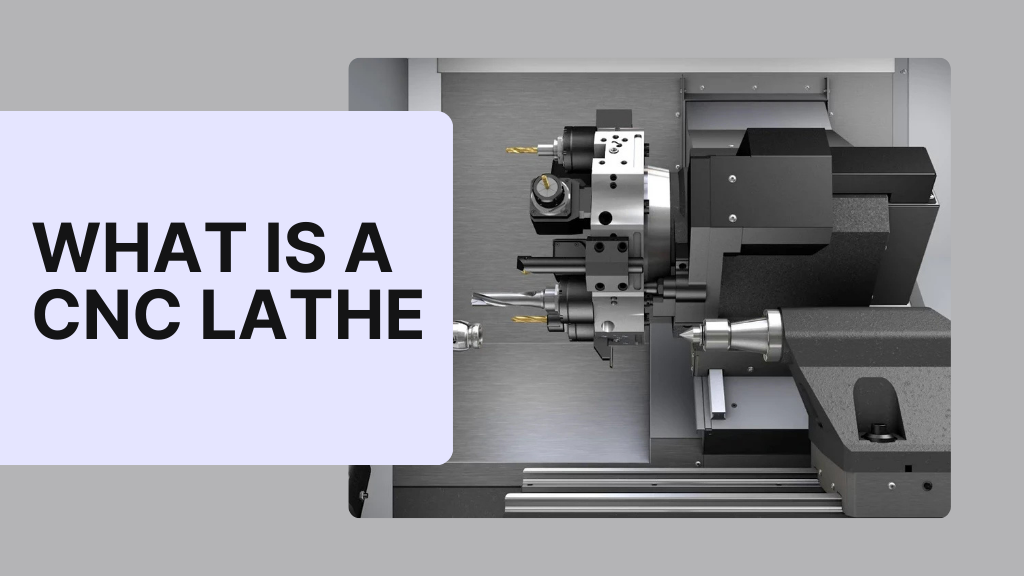CNC technology has transformed modern manufacturing, enabling levels of precision and efficiency that were once impossible. Among the most widely used CNC machines is the CNC lathe, a versatile and powerful tool designed to shape raw materials into high quality finished parts used in industries across the globe.
But what is a CNC lathe, how does it work, and why has it become so indispensable in today’s production world? This guide will cover everything you need to know about CNC lathes, from their functions and benefits to applications, examples, and frequently asked questions. By the end, you will have a clear understanding of why this machine is one of the backbones of industrial production.
What is a CNC Lathe
A CNC lathe is a computer controlled machine tool designed to rotate a workpiece while cutting tools remove material in order to create precise cylindrical, conical, or complex shapes. Unlike traditional manual lathes, CNC lathes rely on programmed instructions. This eliminates most of the human error found in manual machining and allows for consistent, repeatable results across thousands of parts.
In the simplest terms, a CNC lathe is:
- Controlled by a computer for unmatched precision in machining.
- Highly versatile, producing both simple and complex geometries.
- Efficient and fast, cutting down on manual labor and production time.
- Widely used across industries such as automotive, aerospace, defense, and healthcare.
For example, car manufacturers regularly use CNC lathes to produce engine parts, transmission shafts, and brake components. Each of these requires exact specifications and tolerances measured in microns.
How Does a CNC Lathe Work?
Operating a CNC lathe is a blend of digital programming and precision machining. The machine follows computer-generated instructions to shape materials into exact specifications. This combination allows manufacturers to achieve high levels of accuracy while maintaining efficiency. It also reduces manual labor by automating most of the cutting process.
1. Designing the Part
The workflow begins with engineers designing the part using CAD (Computer-Aided Design) software. A 3D model is created with exact dimensions and tolerances for production. This digital blueprint serves as the foundation for the machining process. Without accurate CAD design, achieving precision during manufacturing becomes difficult. It ensures the final product matches the intended design.
2. Generating the Program
Once the CAD model is ready, it is converted into machine instructions using CAM (Computer-Aided Manufacturing) software. These instructions include G-code and M-code, which control tool movement, spindle speeds, and cutting depth. G-code handles tool paths, while M-code manages auxiliary functions. The program is then uploaded to the CNC lathe for execution. This translation ensures seamless communication between design and machine.
3. Preparing the Material
Next, the raw material, often a cylindrical metal or plastic rod, is placed into the lathe chuck. The chuck grips the workpiece tightly to prevent shifting during high-speed rotation. Material preparation is essential for accuracy and safety in machining. If the workpiece is not properly aligned, it can cause errors or damage to tools. This step ensures stability before cutting begins.
4. Spindle Rotation
With the material secured, the spindle begins rotating the workpiece at programmed speeds. The spindle speed depends on the type of material and the required operation. Harder materials may require slower speeds, while softer ones allow faster cutting. Controlled rotation ensures consistent surface finish and accurate dimensions. This step sets the foundation for precise cutting.
5. Tool Operation
Cutting tools then move along programmed axes, primarily X and Z, to shape the workpiece. Each movement is carefully timed and calculated by the machine’s controller. Advanced CNC lathes may include additional axes, such as Y-axis or live tooling, for complex geometries. This allows drilling, milling, or tapping in a single setup. Multi-axis capability improves efficiency and reduces production time.
6. Inspection and Finishing
After machining, the finished part undergoes inspection to confirm accuracy and tolerances. Quality checks are done using calipers, micrometers, or digital measuring tools. Depending on the requirements, secondary processes such as polishing, coating, or heat treatment may follow. These finishing steps enhance durability, appearance, and performance. The result is a high-precision component ready for use.
Key Components of a CNC Lathe
A CNC lathe is built with several important components that work together to ensure precision and efficiency. Each part plays a specific role in machining and contributes to the overall accuracy of the process. Without these components functioning in harmony, it would be difficult to achieve consistent results. Understanding them is essential for both operators and engineers.
-
Spindle
The spindle is responsible for holding and rotating the workpiece during machining. Its speed and direction are controlled by the CNC program based on the material and required cut. A high-quality spindle ensures smooth rotation and accurate results. Since it is constantly in motion, the spindle is one of the most critical components of the lathe.
-
Chuck
The chuck firmly clamps the raw material in place before machining begins. It provides the necessary grip to prevent slipping or misalignment during high-speed rotation. Different types of chucks, such as three-jaw or four-jaw, are used depending on the workpiece. Proper clamping is vital for both safety and precision. Without it, the entire process can be compromised.
-
Tool Turret
The tool turret houses multiple cutting tools and allows the machine to automatically switch between them. This automation reduces downtime and increases productivity during complex machining operations. The turret rotates to position the correct tool for each programmed step. Its ability to carry multiple tools enhances flexibility. This makes it a key component for advanced CNC lathes.
-
Bed
The bed acts as the foundation of the CNC lathe and provides structural stability. It supports other machine components, ensuring they remain aligned during machining. A strong and rigid bed minimizes vibrations, which can negatively affect accuracy. Materials such as cast iron are commonly used to provide durability. A stable bed is essential for maintaining precision over time.
-
Tailstock
The tailstock provides extra support for long workpieces that extend beyond the chuck. It prevents bending or deflection that may occur during rotation. The tailstock can hold tools like drills or reamers, adding to its versatility. It is adjustable, so operators can move it as needed along the bed. This component is particularly important when machining lengthy parts.
-
Control Panel
The control panel is the operator’s interface with the CNC lathe. It allows users to load, edit, and manage machining programs. Operators can monitor spindle speeds, tool positions, and cutting progress through the panel. Modern control panels often feature touchscreens for ease of use. This component bridges human input with machine execution.
-
Coolant System
The coolant system circulates fluid to prevent overheating of both tools and workpieces. It reduces friction, extends tool life, and helps maintain surface finish quality. Coolant also flushes away chips that could interfere with cutting. Depending on the material, different coolants may be used for optimal results. The system ensures smooth and safe machining operations.
Each of these components is essential in its own way and contributes to the performance of a CNC lathe. Together, they ensure precision, safety, and reliability in modern manufacturing.
Types of CNC Lathes
CNC lathes come in several varieties, each designed for specific applications. The choice of lathe depends on the size of the workpiece, the level of precision required, and the complexity of the design. By understanding the different types, manufacturers can select the right machine for their industry needs. Below are the most common types used in modern machining.
-
Horizontal CNC Lathe
The horizontal CNC lathe is the most widely used type in manufacturing. The workpiece is mounted horizontally and rotated while stationary cutting tools shape it into the desired form. These machines are highly efficient for producing standard cylindrical components. They are commonly used in automotive and industrial applications. Their versatility makes them a popular choice for general machining.
-
Vertical CNC Lathe
A vertical CNC lathe mounts the workpiece in a vertical position. This configuration is especially useful for heavy and large-diameter parts that would be difficult to support horizontally. Components such as turbine parts, large bearings, and aerospace landing gear are often produced using vertical lathes. Their design allows gravity to assist in securing the workpiece. These machines are ideal for industries requiring large-scale machining.
-
Swiss Type CNC Lathe
The Swiss type CNC lathe is designed for producing extremely small and precise components. Unlike traditional lathes, the workpiece itself moves while the cutting tools remain fixed. This design minimizes vibration and allows for exceptional accuracy. Industries such as medical device manufacturing and electronics rely heavily on Swiss lathes. They are perfect for high-volume production of miniature parts.
-
Multi Axis CNC Lathe
Multi axis CNC lathes are advanced machines capable of operating on five or even seven axes. This allows them to produce complex geometries in a single setup, reducing the need for multiple machines. Aerospace and defense industries often use these lathes for high-precision, intricate components. Their ability to handle complex cuts makes them valuable for specialized applications. Although more expensive, they significantly boost productivity and accuracy.
CNC Lathe vs CNC Milling Machine
While both CNC lathes and CNC milling machines fall under the CNC machining category, they function very differently.
| Feature | CNC Lathe | CNC Milling Machine |
|---|---|---|
| Workpiece Movement | Rotates | Fixed |
| Tool Movement | Stationary tool moves along 2 to 3 axes | Rotating tool moves along multiple axes |
| Shapes Produced | Cylindrical, conical, threaded | Flat, contoured, or complex 3D parts |
| Best For | Shafts, bushings, fittings | Molds, housings, brackets |
Understanding the distinction helps manufacturers choose the right equipment depending on their product needs.
Advantages of CNC Lathes
CNC lathes are widely used in modern manufacturing because they offer a combination of precision, efficiency, and flexibility. By automating machining processes, they reduce the need for manual labor while producing consistent, high-quality results. These benefits make them essential in industries ranging from automotive to aerospace. Below are some of the key advantages they provide.
1. High Accuracy
CNC lathes deliver exceptional precision, often achieving tolerances as tight as ±0.001 inches. This level of accuracy is crucial in industries where even the smallest error can compromise performance. Whether producing engine parts or medical devices, manufacturers can rely on consistent results. Advanced programming ensures exact movements of the spindle and tools. This makes CNC lathes ideal for precision-driven applications.
2. Consistency
One of the greatest strengths of CNC lathes is their ability to produce thousands of identical parts. Once a program is set, the machine repeats the same process with no variation. This consistency reduces errors and minimizes quality control issues. It also allows companies to meet large production demands without sacrificing accuracy. In mass manufacturing, this advantage is invaluable.
3. Cost Savings
Although CNC lathes require significant upfront investment, they offer long-term cost efficiency. Automated processes reduce labor costs by minimizing the need for manual machining. Material waste is also significantly lowered, as precise cuts maximize usage. Faster production cycles mean more parts are produced in less time. Over the long run, these savings can outweigh the initial purchase costs.
4. Speed
CNC lathes are designed for fast and efficient operation. Automatic tool changes and optimized programming reduce downtime between processes. Complex parts that would take hours manually can be completed in a fraction of the time. The ability to operate continuously for long periods also improves productivity. This makes them essential in industries that demand quick turnaround times.
5. Versatility
These machines are capable of working with a wide range of materials, including metals, plastics, composites, and even wood. This versatility allows manufacturers to serve multiple industries with the same equipment. CNC lathes can perform different operations such as drilling, threading, and turning within one setup. Their adaptability makes them a cost-effective investment. Companies can expand production without purchasing multiple machines.
6. Complex Designs
CNC lathes can create intricate designs that are not possible with traditional manual lathes. Advanced multi-axis models allow for the machining of parts with complex geometries. This capability is particularly important in aerospace, medical, and defense industries. Engineers can design innovative components without worrying about manufacturing limitations. As a result, CNC technology fosters creativity and innovation in product design.
7. Improved Safety
Safety is another significant advantage of CNC lathes. Since most operations are automated, operators have less direct contact with cutting tools. Enclosures and safety systems further reduce the risk of accidents. By minimizing human involvement in dangerous steps, the machines create a safer work environment. This not only protects workers but also reduces downtime from workplace incidents. In industries with strict safety standards, this is a major benefit.
Applications of CNC Lathe
CNC lathes are essential in nearly every manufacturing sector. Examples include:
- Automotive shafts, engine parts, brake systems, and gear components.
- Aerospace landing gear, turbine blades, and critical flight components.
- Medical and Healthcare surgical implants, screws, and specialized instruments.
- Oil and Gas valves, pipe fittings, and heavy duty components.
- Electronics connectors, casings, and precision housings.
- Defense firearm components, armored vehicle parts, and aerospace defense systems.
The versatility of CNC lathes explains why they are in demand across both large scale industrial facilities and specialized precision shops.
Real World Example of CNC Lathes in Use
A medical equipment manufacturer in the United States invested in Swiss type CNC lathes for producing bone screws and surgical implants. The company reported:
- Forty percent faster production times.
- Thirty percent reduction in manufacturing costs.
- Higher accuracy and compliance with FDA requirements.
This demonstrates how CNC lathes do more than just save money. They can directly impact product safety and reliability.
Challenges of CNC Lathes
While CNC lathes provide many advantages, there are also challenges:
- Initial investment can be high, often starting around fifty thousand dollars and reaching two hundred thousand or more.
- Skilled operators are necessary since programming requires knowledge and training.
- Maintenance costs must be factored in for long term use.
- Large machines consume significant amounts of energy.
Despite these challenges, most manufacturers find that the return on investment justifies the cost.
The Future of CNC Lathe
CNC lathe technology continues to evolve. Current and upcoming trends include:
- Artificial intelligence integration for predictive maintenance and smart machining.
- Robotic automation for 24 hour lights out production.
- IoT connectivity that allows real time performance monitoring.
- Hybrid machines combining CNC lathing with additive manufacturing.
These innovations will ensure that CNC lathes remain a central part of the global manufacturing landscape.
Conclusion
So what is a CNC lathe? It is one of the most essential tools in modern manufacturing. By combining computer precision with machining power, it creates high quality parts that are consistent, efficient, and reliable. From tiny medical implants to massive aerospace components, CNC lathes drive innovation across industries worldwide.
As technology continues to advance with AI, robotics, and smart connectivity, CNC lathes will remain at the center of industrial progress. Whether you are a beginner exploring manufacturing or a professional looking to optimize production, understanding CNC lathes is vital for staying competitive in the future of production.
FAQs
What is a CNC lathe used for?
A CNC lathe is used to produce cylindrical and conical parts such as shafts, bushings, bolts, pipes, and implants.
How much does a CNC lathe cost?
Basic machines start around forty thousand dollars while advanced multi axis models can exceed two hundred thousand dollars.
What materials can CNC lathes machine?
They can handle metals such as steel, aluminum, and titanium, along with plastics, ceramics, and composite materials.
Is a CNC lathe better than a manual lathe?
Yes, CNC lathes provide higher accuracy, faster speeds, and better repeatability. Manual lathes are still used for simple, one off projects.
Which industries rely most on CNC lathes?
Automotive, aerospace, healthcare, defense, and electronics industries are the heaviest users.




